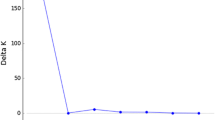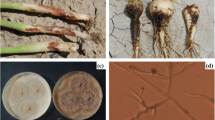Abstract
Zingiber zerumbet (L) Smith, a wild clonal species related to the cultivated ginger (Zingiber officinale Roscoe), is a potential resistance donor for soft rot disease in ginger caused by Pythium aphanidermatum (Edson) Fitzp. In this study we evaluated the genetic diversity and P. aphanidermatum resistance of 74 Z. zerumbet accessions belonging to 15 populations from eight districts in Kerala state, India. The disease index (DI) of the accessions varied from 0% to 72.24% and the accessions could be separated into six frequency classes according to their DI values. More than 65% of the accessions had a DI < 20%. Eight accessions were found to be immune to the infection. The relative frequency of resistant accessions was higher in the central and northern regions of Kerala. Amplified fragment length polymorphism (AFLP) analysis of Z. zerumbet accessions using five primer combinations yielded 215 bands in total, of which 175 (81.4%) were polymorphic. Nei’s genetic diversity (h) of 0.2738 and Shannon information index (I) of 0.4012 revealed a high genetic diversity in Z. zerumbet unexpected for a clonal species. In the UPGMA dendrogram, accessions were clustered mostly according to their geographical origin and no clear correspondence was observed between the clustering pattern of accessions and their responses to Pythium aphanidermatum. The study revealed high genetic diversity and variability for pathogen resistance among Z. zerumbet accessions and confirmed the value of Z. zerumbet as a potential donor for soft rot resistance for the genetic improvement of ginger.


Similar content being viewed by others
References
Adandonon A, Aveling TAS, Tamo M (2004) Occurrence and distribution of cowpea damping-off and stem rot and associated fungi in Benin. J Agri Sci 142:561–566
Aigner PA (2004) Ecological and genetic effects on demographic processes: pollination, clonality and seed production in Dithyrea maritima. Biol Conserv 116:27–34
Bengtsson BO (2003) Genetic variation in organisms with sexual and asexual reproduction. J Evol Biol 16:189–199
Bensch S, Akesson M (2005) Ten years of AFLP in ecology and evolution: why so few animals? Mol Ecol 14:2899–2914
Ceplitis A (2001) The importance of sexual and asexual reproduction in the recent evolution of Allium vineale. Evol 55:1581–1591
Chaboudez P, Burdon JJ (1995) Frequency-dependent selection in a wild plant-pathogen system. Oecologia 102:490–493
Chen J-M, Gituru WR, Wang Y-H, Wang Q-F (2006) The extent of clonality and genetic diversity in the rare Caldesia grandis (Alismataceae): Comparative results for RAPD and ISSR markers. Aquatic Bot 84:301–307
Collonnier C, Fock I, Mariska I, Servaes A, Vedel F, Siljak-Yakovlev S, Souvannavong V, Sihachakr D (2003) GISH confirmation of somatic hybrids Solanum melongena and S. torvum: assessment of resistance to both fungal and bacterial wilts. Pl Physiol Biochem 41:459–470
Dake GN (1995) Diseases of ginger (Zingiber officinale Rosc.) and their management. J Sp Arom Crops 4:40–48
Dake GN, Edson S (1989) Association of pathogens with rhizome rot of ginger in Kerala. Indian Phytopath 42:116–119
Dodd RS, Daniel H, Douhovnikoff V, Harnik TY, Zara A-R, Matteo G (2005) Is variation in susceptibility to Phytophthora ramorum correlated with population genetic structure in coast live oak (Quercus agrifolia)? New Phytol 165:203–214
Dong M, Lu B-R, Zhang H-B, Chen J-K, Li B (2006) Role of sexual reproduction in the spread of an invasive clonal plant Solidago canadensis revealed using intersimple sequence repeat markers. Plant Sp Biol 21:13–18
Dybdahl MF, Lively CM (1995) Diverse, endemic and polyphyletic clones in mixed populations of a freshwater snail (Potamopyrgus antipodarum). J Evol Biol 8:385–398
Ellstrand NC, Roose ML (1987) Patterns of genotypic diversity in clonal plant species. Am J Bot 74:123–131
Fernie AR, Tadmor Y, Zamir D (2006) Natural genetic variation for improving crop quality. Curr Opin Plant Biol 9:196–202
Folman LB, Postma J, van Veen JA (2003) Inability to find consistent bacterial biocontrol agents of Pythium aphanidermatum in cucumber using screens based on ecophysiological traits. Microb Ecol 45:72–87
Gabrielsen TM, Brochmann C (1998) Sex after all: high levels of diversity detected in the arctic clonal plant Saxifraga cernua using RAPD markers. Mol Ecol 7:1701–1708
Gil L, Fuentes-Utrilla P, Soto A, Cervera MT, Collada C (2004) English elm is a 2,000 year old Roman clone. Nature 431:1053
Gonzalez G, Aleman S, Infante D (2003) Asexual genetic variability in Agave fourcroydes II: selection among individuals in a clonally propagated population. Plant Sci 165:595–601
Goodman RM, Hauptli H, Crossway A, Kanauf VC (1987) Gene transfer in crop improvement. Science 236:48–54
Grando S, von Bothmer R, Ceccarelli S (2001) Genetic Diversity of Barley: Use of Locally Adapted Germplasm to Enhance Yield and Yield Stability of Barley in Dry Areas. In: Cooper HD, Spillane C, Hodgink T (eds) Broadening the Genetic Base of Crop Production, CABI, New York (U.S.A.)/FAO, Rome (Italy)/IPRI, Rome (Italy), pp 351–372
Hamrick JL, Godt MJW (1989) Allozyme diversity in plant species. In: Brown AHD, Clegg MT, Kahler AL, Weir BS (eds) Plant Population Genetics, Breeding and Genetic resources. Sinauer Associates Inc., Sunderland, Massachusetts, USA
Infante D, Gonzalez G, Peraza-Echeverria L, Keb-Llanes M (2003) Asexual genetic variability in Agave fourcroydes. Plant Sci 164:223–230
Jiang H, Xie Z, Koo HJ, McLaughlin SP, Timmermann BN, Gang DR (2006) Metabolic profiling and phylogenetic analysis of medicinal Zingiber species: Tools for authentication of ginger (Zingiber officinale Rosc.). Phytochemistry 67:1673–1685
Kavitha PG, Thomas G (2007) Evaluation of Zingiberaceae for resistance to ginger soft rot caused by Pythium aphanidermatum (Edson) Fitzp. Plant Gent Resorc News Lett (in press)
Koga K, Kadono Y, Setoguchi H (2007) The genetic structure of populations of the vulnerable aquatic macrophyte Ranunculus nipponicus (Ranunculaceae). J Plant Res 120:167–174
Kozlowski G, Metraux J-P (1998) Infection of Norway spruce (Picea abies (L.) Karst. seedlings with Pythium iregulare Buism. and Pythium ultimum Trow.: histological and biochemical responses. Eur J Plant Pathol 104:225–234
Kulkarni RM, Baskaran K (2003) Inheritance of resistance to Pythium dieback in the medicinal plant periwinkle. Plant Breeding 122:184–187
Lawrence BM (1984) Major tropical spices-Ginger (Zingiber officinale Rosc.). Perfumer & Flavorist 9:1–40
Li W, Wang B, Wang J (2006) Lack of genetic variation of an invasive clonal plant Eichhornia crassipes in China revealed by RAPD and ISSR markers. Aquatic Bot 84:176–180
Makhuvha N, van Wyk B-E, van der Bank H, van der Bank M (1997) Genetic polymorphism in wild and cultivated Siphonochilus aethiopicus (Zingiberaceae). Biochem Syst Ecol 25:343–351
Myers N, Mittermeier RA, Mittermeier CG, da Fonseca GA, Kent J (2000) Biodiversity hotspots for conservation priorities. Nature 403:853–858
Pollux BJ, Jong MD, Steegh A, Verbruggen E, van Groenendael JM, Ouborg NJ (2007) Reproductive strategy, clonal structure and genetic diversity in populations of the aquatic macrophyte Sparganium emersum in river systems. Mol Ecol 16:313–325
Price EAC, Marshall C (1999) Clonal plants and environmental heterogeneity. Pl Ecol 141:3–7
Ramachandran K (1969) Chromosome numbers in Zingiberaceae. Cytologia 34:213–221
Rohlf F (2000) NTSYS-pc: Numerical taxonomy and multivariate analysis system, version 2.02 i. Exeter Software, New York
Sanchez G, Restrepo S, Duque MC, Fregene M, Bonierbale M, Verdier V (1999) AFLP assessment of genetic variability in cassava accessions (Manihot esculenta) resistant and susceptible to the cassava bacterial blight (CBB). Genome 42:163–172
Siemens DH, Roy BA (2005) Tests for parasite-mediated frequency-dependent selection in natural populations of an asexual plant species. Evol Ecol 19:321–338
Sole M, Durka W, Eber S, Brandl R (2004) Genotypic and genetic diversity of the common weed Cirsium arvense (Asteraceae). Int J Pl Sci 165:437–444
Song J, Bradeen JM, Naess Sk, Raasch JA, Wielgus SM, Haberlach GT, Liu J, Kuang H, Austin-Phillips S, Buell CR, Helgeson JP, Jiang J (2003) Gene RB cloned from Solanum bulbocastanum confers broad spectrum resistance to potato late blight. Proc Natl Acad Sci USA 100:9128–9133
Sousa ME, Dias JS, Monteiro AA (1997) Screening portugese cole landraces for resistance to seven indigenous downy mildew isolates. Sci Hort 68:49–58
Sun GL, Bond M, Nass H, Martin R, Dong Z (2003) RAPD polymorphisms in spring wheat cultivars and lines with different level of Fusarium resistance. Theor Appl Genet 106:1059–1067
Tek AL, Stevenson WR, Helgeson JP, Jiang J (2004) Transfer of tuber soft rot and early blight resistances from Solanum brevidens into cultivated potato. Theor Appl Genet 109:249–254
Wahyuni S, Xu DH, Bermawie N, Tsunematsu H, Ban T (2003) Genetic relationships among ginger accessions based on AFLP marker. J Bioteknologi Pertanian 8:60–68
Wang B, Li W, Wang J (2005) Genetic diversity of Alternanthera philoxeroides in China. Aquatic Bot 81:277–283
Yap I, Nelson RJ (1996) WinBoot: a program for performing bootstrap analysis of binary data to determine the confidence limits of Upgma-based dendrograms. IRRI Discussion paper series no 14, International Rice Research Institute, Manila, Philippines
Yeh FC, Yang R, Boyle T (1999) POPGENE version 1.31: Microsoft Windows-based Freeware for population genetic analysis. http:/www.uabertaca/∼fyeh
Acknowledgements
KPG gratefully acknowledges the Council for Scientific and Industrial Research (CSIR), Government of India for the research fellowship (File No. 9/716(024)/2KI/EMR-I) and GT acknowledges the Department of Biotechnology (DBT), Government of India for financial support (Grant No. BT/PR2211/Agr/08/162/2001).
Author information
Authors and Affiliations
Corresponding author
Rights and permissions
About this article
Cite this article
Kavitha, P.G., Thomas, G. Population genetic structure of the clonal plant Zingiber zerumbet (L.) Smith (Zingiberaceae), a wild relative of cultivated ginger, and its response to Pythium aphanidermatum . Euphytica 160, 89–100 (2008). https://doi.org/10.1007/s10681-007-9557-5
Received:
Accepted:
Published:
Issue Date:
DOI: https://doi.org/10.1007/s10681-007-9557-5




